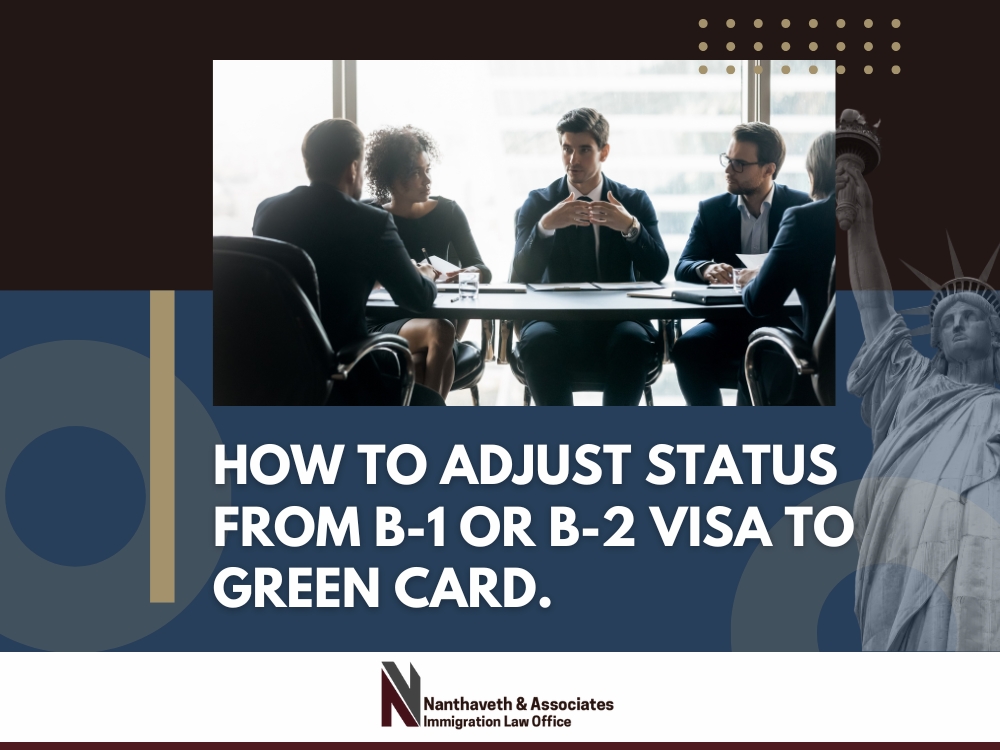How to Go From a B-1 or B-2 Visa to a Green Card

If you're a foreign national with a B-1 or B-2 visa, you may be wondering whether it's possible to get U.S. residency. The answer is yes – it is possible to transition from a B-1 or B-2 visa to a green card. But you must be eligible for a green card through one of these ways:
- You have a qualifying family member who's also a U.S. citizen or lawful permanent resident (green card holder)
- An employer has offered you a job in the United States.
- You have been granted asylum or refugee status in the United States.
- You have extraordinary ability in the arts, sciences, business, athletics, or education.
- You're an outstanding researcher or professor, or you're a multinational executive or manager who meets specific criteria under the Immigration and Nationality Act (INA)
- You're a physician, and you're willing to agree to work full-time in an underserved area.
- You're a religious worker, or you worked for the U.S. government in Iraq or Afghanistan.
- You're an international broadcaster or part of a certain international organization.
- You're an investor willing to invest capital in a U.S. company that creates jobs for Americans.
- You're the victim of human trafficking, domestic violence or some other types of crimes.
This guide explains the process step by step so that you can make the transition smoothly.
What Is The Difference Between a B-1 and B-2 Visa
The B-1 and B-2 visas are nonimmigrant visas for temporary visits to the U.S. A B-1 visa is for business activities like conferences, contract negotiations, or consulting. The B-2 visa is for tourism, leisure, or visiting friends and family. Both are short-term visas, and applicants must show they plan to return to their home country after their stay.
The main difference is the purpose of travel. The B-1 visa is for business-related activities but prohibits paid employment in the U.S. The B-2 visa is for leisure, medical treatment, or social visits and also does not allow work or study.

B-1 or B-2 Visa to a Green Card Guide
First things first: Many people who want to go from a B-1 or B-2 visa to a green card choose to work with an Austin immigration attorney who understands U.S. immigration law. That's because immigration law is pretty complicated, and it's always subject to change.
A significant amount of paperwork is involved in transitioning from a B-1 or B-2 visa (both of which are temporary visas) to a green card, which offers permanent residency in the United States. One mess-up on your paperwork could result in your application being returned to you - or worse, being rejected entirely.
What Are the Benefits of Getting a U.S. Green Card?
There are plenty of good reasons to want a green card. For starters, it allows you to live and work permanently in the United States. You'll also be able to travel in and out of the country freely and apply for citizenship if you so choose (though that's not a requirement).
A green card also makes it easier to bring your family to the United States. If you have a spouse or children who live in another country, you can sponsor them for green cards as well. And once they have their green cards, they'll be able to live and work in the United States just like you can.
Finally, having a green card gives you access to certain benefits that you wouldn't have as a foreigner with a B-1 or B-2 visa. For example, you'll be eligible for Social Security and Medicare benefits once you have a green card. You'll also be able to get a driver's license and open a bank account more easily.
B-1/B-2 Visa Duration: “Isn’t a B-1/B-2 Visa Temporary?”B-1 and B-2 visas are temporary visas for visitors. The U.S. Customs and Border Protection (CBP) officer determines the length of stay upon entry, usually up to six months or 180 days, though shorter stays may be given. It’s important to leave before your authorized stay ends to avoid penalties or visa issues. To request an extension, file Form I-539 with U.S. Citizenship and Immigration Services (USCIS) before your stay expires, including proper documentation and a valid reason. However, that doesn't mean you can't apply for a green card.You must be careful, though. If USCIS thinks you were never planning on staying temporarily on your B-1/B-2 visa, they can deny your petition and place you in removal proceedings for not following the terms of your visa. That’s what it is essential that you work with an experienced immigration lawyer when adjusting from a B-1/B-2 visa to a green card.
What is Adjustment of Status? (B-1 and B-2 to I-485)
Adjustment of status is the process of transitioning from a temporary visa to a green card. It's also possible to adjust your status if you hold another type of visa, such as an H-1B visa (for workers in certain specialty occupations) or an L-1 visa (for executives and managers who are transferring to the United States to work for a subsidiary of their foreign company).
If you have a B-1 or B-2 visa, you can adjust your status by asking your immigration attorney to file Form I-485 with U.S. Citizenship and Immigration Services (USCIS) a long with an immigrant petition.

After USCIS has received and processed your Form I-485, you'll be scheduled for an interview at a USCIS office. The interviewer will ask you questions about your application and eligibility for a green card. If everything goes well, you'll be approved for a green card and receive it in the mail a few weeks later.
What Are the Eligibility Requirements for Adjustment of Status?
To be eligible for adjustment of status, you must meet certain requirements. For example, you must have entered the United States legally and with a valid visa. You also can't have stayed in the country for more than 180 days on your B-1 or B-2 visa. Also:
- You must be physically present in the United States.
- You must be eligible for an immigrant visa.
- An immigrant visa must be immediately available to you when you file for adjustment of status and when USCIS makes a final decision in your case.
- You must be admissible to the United States or be eligible for a waiver of inadmissibility
What is a Waiver of Inadmissibility?
A waiver of inadmissibility is a document that allows you to bypass certain grounds of inadmissibility and enter the United States anyway. For example, let's say you entered the United States on a B-1 visa to attend a conference, but you stayed for longer than the 180 days allowed by your visa. In this case, you would be inadmissible to the United States.
However, if you have a waiver of inadmissibility, you can still enter the country. Waivers are available for a number of different grounds of inadmissibility, including:
- Health-related grounds
- Criminal history
- Unlawful presence in the United States
- Certain immigration violations
What Happens if You’re Inadmissible?
If you're inadmissible to the United States, that doesn't mean you can never come to the country again. It just means that you need to get a waiver of inadmissibility before you can enter.
You can apply for a waiver of inadmissibility through your attorney. Your attorney will file Form I-601 with USCIS. You'll also need to submit other forms and documents. After USCIS has received and processed your Form I-601, you'll be scheduled for an interview at a USCIS office. The interviewer will ask you questions about your inadmissibility and your waiver application. If everything goes well, you'll be approved for a waiver and be able to enter the United States.
What's the Easiest Way to Adjust Status and Get a Green Card From a B-1 or B-2 Visa?
One of the most common ways people go from a B-1 or B-2 visa to a green card is through marriage. If you're in the United States and marry a U.S. citizen, you can apply for a green card through adjustment of status. The process is relatively simple and straightforward, and you won't have to leave the United States during the process.
To adjust your status and get a green card through marriage, your attorney can file Form I-485 with USCIS. You'll also need to submit additional forms and documents; your attorney can explain exactly what is required.
You don't have to marry a U.S. citizen, though (and you shouldn't if you're only doing so to gain an immigration benefit - that's illegal and will get you deported from the United States). Your attorney may be able to file Form I-485 to adjust your status if:
- You have a qualifying family member who's also a U.S. citizen or lawful permanent resident (green cardholder)
- An employer has offered you a job in the United States.
- You have been granted asylum or refugee status in the United States.
- You have extraordinary ability in the arts, sciences, business, athletics or education.
- You're an outstanding researcher or professor, or you're a multinational executive or manager who meets specific criteria under the Immigration and Nationality Act (INA)
- You're a physician, and you're willing to agree to work full-time in an underserved area.
- You're a religious worker or you worked for the U.S. government in Iraq or Afghanistan.
- You're an international broadcaster or part of a certain international organization.
- You're an investor willing to invest capital in a U.S. company that creates jobs for Americans.
- You're the victim of human trafficking, domestic violence, or some other types of crimes.
Do You Need to Talk to an Attorney About How to Go From a B-1 or B-2 Visa to a Green Card?
Due to B-1 and B-2 visas being nonimmigrant visas, it can be complicated to adjust your status to a green card. If you're interested in going from a B-1 or B-2 visa to a green card, we can help you. Call our office today to schedule a consultation with an Austin immigration attorney who can give you the answers and legal guidance you need.


11211 Taylor Draper Lane Suite 107
Austin, TX 78759
Tel: (512) 828-3791
Hours: 8:00 AM - 6:00 PM
Payment: all major credit cards, cash, check, money orders, cashiers check
Directions To Our Office
Areas Of Service
Copyright © 2025 | Nanthaveth & Associates | Immigration Law Firm Marketing Specialist MarketCrest
Not all consultations are free, and they are not all conducted by Vi Nanthaveth.
